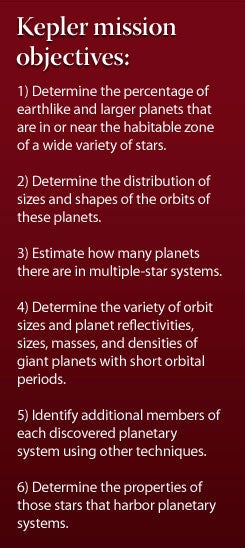
March 3, 2009
WAUKESHA, Wis. — This year, astronomers will continue their planet quest with a specialized spacecraft designed to detect earthlike planets around stars similar to the Sun. NASA has scheduled the Kepler mission for launch no earlier than March 6. There are two launch windows, from 10:49 p.m. – 10:52 p.m. and 11:13 p.m. – 11:16 p.m. EST.
Astronomy magazine editors are available to explain the significance of the Kepler mission. To request an interview, please contact Matt Quandt at 262.798.6484 or mquandt@kalmbach.com.
Kepler contains a 55-inch (1.4 meters) primary mirror. This light-collector feeds a 37.5-inch (0.95m) photometer, a high-precision device that measures light intensity. Scientists have attached to it a 95-megapixel detector, consisting of 42 charge-coupled devices (CCDs). The craft’s mission is to monitor 100,000 stars between 9th and 16th magnitude. This brightness range contains objects some 15 to 10,000 times fainter than the human eye can detect.
Kepler’s camera has a field of view of 105 square degrees. It will continuously point to an area of sky in the northern constellations Lyra and Cygnus. These two star patterns lie along the summer Milky Way for Northern Hemisphere observers.
Kepler will monitor the stars’ brightnesses with a precision of one part in 100,000 to detect dimming caused by transiting Earth-sized planets. The Kepler mission will provide a statistical measure of the occurrence of planets from Earth-sized to Neptune-sized orbiting within twice the Earth-Sun distance around normal stars. For the first time, astronomers may determine how common other rocky worlds are.
Kepler mission homepage: kepler.nasa.gov/.
Astronomy‘s mission:
Astronomy promotes the science and hobby of astronomy through high-quality publications that engage, inform, entertain, and inspire.
More resources from Astronomy.com:
- Astronomy news
- Astronomy basics
- Glossary of astronomical terms
- Return to Astronomy “For the media” page









